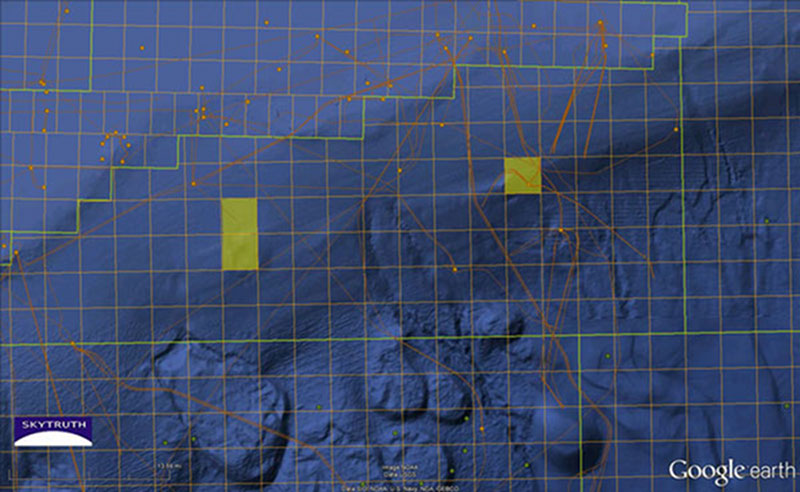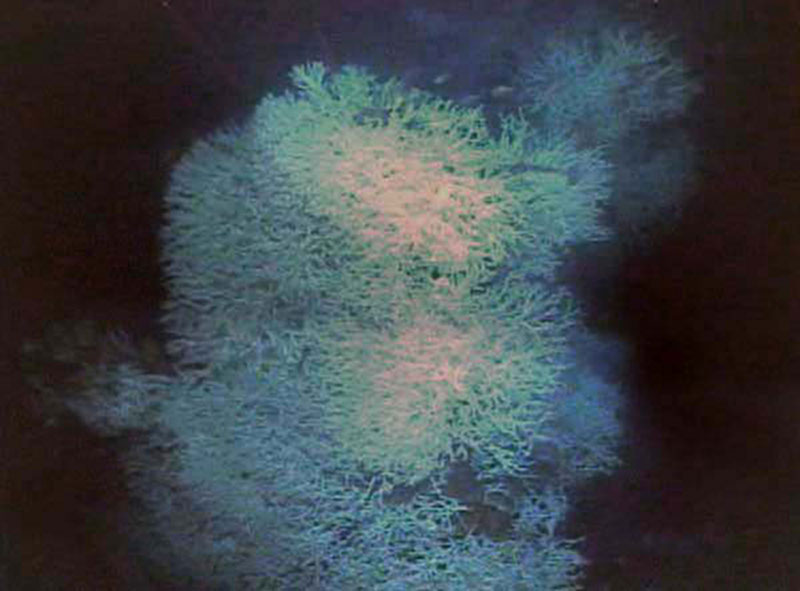
By Cheryl L. Morrison and Dr. Katharine Coykendall - U.S. Geological Survey, Leetown Science Center

This map shows the Viosca Knoll area of the Gulf, where the most developed natural Lophelia reefs exist (VK-826 in yellow square on right and VK-862/906 on left). The orange dots are oil platforms and the orange lines represent pipelines. There are numerous platforms in close proximity to the VK reefs. Natural cold seep sites greater than 1,000 meters depth are shown in green. Image courtesy of Skytruth,www.skytruth.org . Download larger version (jpg, 525 KB).
The deep ocean is often thought of as a vast expanse, devoid of substantial biota save for rare oases (i.e., hydrothermal vents, cold seeps, seamounts, deep water reefs). Often many kilometers of seabed unsuitable for settlement and survival separate these islands of life. How the inhabitants of these rare biodiversity hotspots manage to disperse, colonize, and thrive under such seemingly unfavorable conditions is of great interest to many scientists.
Population connectivity is the exchange of individuals among geographically separated populations. For benthic organisms such as corals, connectivity occurs when larvae from one population disperse via ocean currents to another population, where they settle, grow, and reproduce, therefore contributing to the new population and linking the populations through shared genetic makeup.
Connectivity affects both population structure and genetic diversity, and may play a role in resiliency when faced with human and environmental disturbances. Because connectivity is nearly impossible to directly measure due to the immense space in which tiny larvae have to disperse, sampling organisms from different reefs and indirectly measuring genetic connectivity and population structuring may be the only way to understand how these populations are connected to each other. Therefore, one of our primary research objectives in the Lophelia II project is to assess patterns of population connectivity among natural and potential artificial reefs in the Gulf of Mexico.
During the Lophelia I studies, we collected samples from three natural Lophelia sites, Viosca Knoll (VK) 826, VK 862, and Green Canyon. Through comparisons of shared genetic diversity among these sites, we concluded that connectivity appeared high among these sites that spanned about 370 kilometers in the northern Gulf.
The Lophelia II expeditions have taken us to several additional natural reefs (Garden Banks 535, Mississippi Canyon 751, VK 906 and the West Florida Slope), increasing our geographic coverage to approximately 900 kilometers in the Gulf. We’ve also sampled two ‘artificial reefs’ that were covered with significant Lophelia growth: the tankers Gulf Penn and Gulf Oil. We will now have substantially more power to assess Lophelia connectivity patterns throughout the Gulf.
Artificial Deep Reefs

The Lophelia colonies at the Gulfpenn Wreck site exhibit 4.6 meters (15 feet) of vertical relief along the superstructure. It is literally a wall of coral. Image courtesy of Lophelia II Team 2009, NOAA-OER. Download image (jpg, 66 KB).
Shipwrecks and oil platforms in the Gulf may serve as artificial reefs that attract fishes and invertebrates. Since corals require hard substrate, such as rocks, to settle and grow, reef formation may be limited by space availability. However, human-made structures such as shipwrecks and oil platforms may provide substrate for coral settlement. Given that these structures often sit well above the sea floor, corals that settle on them may benefit from strong, nutrient-rich currents that deliver food and remove sediment that could otherwise inhibit survival and/or growth.
In the North Sea, significant Lophelia has been documented on numerous oil and gas platforms and these populations have been called an ‘oasis on the sea bed where life is relatively sparse’ (Gass & Roberts, 2004). Coral growth on these structures may attract typical Lophelia reef organisms, such as fishes and invertebrates, enhancing biodiversity.
Cruise Sampling
Oil and gas platforms occur in large numbers in the Gulf and therefore have the potential to make a substantial contribution to connectivity of Lophelia reefs. During this cruise, we plan to use the Kraken II remotely operated vehicle to sample Lophelia corals from five to six platforms.
Back in the lab, we will use variable genetic markers developed for Lophelia to obtain a ‘genetic fingerprint’ for each sample. Through comparisons of these genetic fingerprints, we will be able to pinpoint which natural populations may have contributed larvae (sources) that are responsible for the growth of Lophelia we observe on the platforms (sinks).
If platforms occur in appropriate locations and depths, they may increase connectivity among natural reefs, potentially adding resilience to the Gulf Lophelia community in the face of future environmental change or disturbance. An interesting aspect of the platform populations is the known age of the structures, which sets a maximum age boundary on the corals as well. Since natural reefs are likely thousands of years old, population structuring may differ substantially between natural and artificial reefs. The known age of the structures also allows for growth rate studies.
Final Pieces of the Puzzle
Collections made during this cruise will be included in our analyses of connectivity among natural and artificial Lophelia reefs in the Gulf. The result should be a much more comprehensive picture of connectivity patterns and should allow assessment of the ecological importance of artificial reefs to the longevity of natural populations. Additional data being collected by the Lophelia II team will help us interpret our results. Since little is known about deep-water bottom currents on an annual basis, results from current meters may help us interpret genetic estimates of connectivity patterns.
We are also examining connectivity patterns in the squat lobster, Eumunida picta, which is a common inhabitant of Lophelia reefs. Other members of the team are examining connectivity among octocorals (Andrea Quattrini), black corals (Dannise Ruiz), and brittle stars (Tim Shank and Walter Cho).
By comparing population structure patterns among different species with divergent life histories within the same habitats, we can draw conclusions about the mechanisms driving dispersal. Contrasting population structure patterns among species indicates that divergent life histories may be the driving force behind population structure (i.e. mobile vs sessile, lecithotrophic vs planktotrophic larvae) whereas similar population structure patterns among species within the same habitat may indicate that physical forces such as prevailing currents, temperature, and/or pressure regimes may be influencing the recruitment and settlement of all inhabitants in kind. The combined knowledge from the connectivity studies in the Lophelia II research program will tell us a lot about the biology and ecology of these deep and hard to access ecosystems.